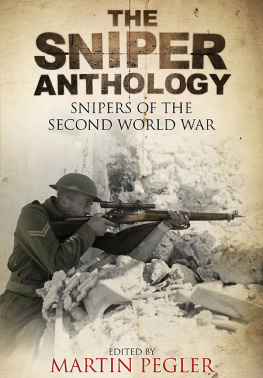THE NEW ORLEANS SNIPER
A Phenomenological Case Study of
Constituting the Other
Frances Chaput Waksler

Copyright 2010 by
University Press of America, Inc.
4501 Forbes Boulevard
Suite 200
Lanham, Maryland 20706
UPA Acquisitions Department (301) 459-3366
Estover Road
Plymouth PL6 7PY
United Kingdom
All rights reserved
Printed in the United States of America
British Library Cataloging in Publication Information Available
Library of Congress Control Number: 2010936059
ISBN: 978-0-7618-5389-3 (paperback : alk. paper)
elSBN: 978-0-7618-5390-9
 The paper used in this publication meets the minimum
The paper used in this publication meets the minimum
requirements of American National Standard for Information
SciencesPermanence of Paper for Printed Library Materials,
ANSI Z39.48-1992
TO
Professor George Psathas
Professor Erazim Kohk
Professor John Mogey
Professor Julius A. Roth
with gratitude for the knowledge and
support offered me throughout the years
Contents
PREFACE
In January 1973 I followed with great interest the television news broadcasts of sniping from the Downtown Howard Johnsons Motel in New Orleans and, after the death of the first sniper, the ultimately unsuccessful search for a second sniper. I was just finishing my dissertation, The Essential Structures of Face-to-Face Interaction: A Phenomenological Analysis, in which I explored how a person identifies an Other as an interactional Other. I immediately saw the New Orleans event as the basis for a case study of that topic: how was a second sniper first identified as an Other and then denied existenceor, as I would say now, first constituted and then unconstituted?
I did not pursue the topic at that time, but the intriguing aspects of the case remained with me. A turning point came in 2002 when, on a whim, I phoned the offices of The New Orleans Times-Picayune and spoke with the Head Librarian, Nancy Burris. When I told her of my interest in the sniper case, she said that she would send me an extensive file of clippings from both The Times-Picayune and The New Orleans States-Item that, given the interest in the event at the time, she had compiled. Data in hand, I was ready to begin.
Over the years, as I was consulting the works of Edmund Husserl for other writing projects, the relevance of his analysis to the sniping event continued to come to mind. Of direct relevance were his discussions of the constitution of the Other, issues that might be demonstrated empirically by the New Orleans sniper data.
The only conceivable manner in which others can have for me the sense and status of existent others, thus and so determined, consists in their being constituted in me as others. If they get that sense and status from sources that yield a continual confirmation, then they do exist (as I am compelled to say), but exclusively as having the sense with which they are constituted... (Fifth Cartesian Meditation, 1960: 128, emphasis in original).
How is such confirmation achieved? When continual confirmation fails, what follows?
With Husserls texts in one hand and newspaper clippings in the other, I set to work. The sniper data to follow discloses in detail the processes whereby constitutionand, eventually, unconstitutionof an Other can occur.
Frances Chaput Waksler
Cambridge, MA
August 2010
ACKNOWLEDGMENTS
My first debt of gratitude is to Nancy Burris, Head Librarian, The Times-Picayune (New Orleans), who provided me extensive newspaper accounts of the event, both contemporaneous and retrospective, as well as assistance throughout the research process. Without her help this project would not have been possible. Irene Wainwright, Archivist, New Orleans Public Library, gave me access to the August 31, 1973 New Orleans Police Department Report, the only available copy since Hurricane Katrina had destroyed the Police Departments copy. Both were gracious as well as efficient. Professors Jeff Coulter and Maxine Sheets-Johnstone read early drafts of the material and provided encouragement. Professor Greg Smith offered useful insights. Professor Kenneth Lieberman urged me forward, imagining what such a book would look like (even to back cover reviews). Two anonymous readers also gave helpful suggestions. I had the opportunity to present portions of this material at the meetings of the Society for Phenomenology and the Human Sciences (Boston, MA 2003) and as a keynote address at the meetings of the International Human Science Research Conference (St. Catharines, Ontario, 2004) organized by Professor Maureen Connolly. Lieutenant Stephen Carrabino of the Somerville, MA Police Department reviewed materials in light of my goal of fairly and sympathetically presenting the police involved in the event and provided help in clarifying some aspects of the police report. Professor Lester Embree offered helpful information when I needed it. Samantha M. Kirk and Brian DeRocco of University Press of America were always available with just the answers I needed. Laura Cherry carefully copy edited the manuscriptnot everyone has a poet as a copyeditor. Norman Waksler has lived with this project for many years and read innumerable drafts, keeping a particularly careful eye on my prose style.
Materials from The Times-Picayune and The States Item 2010 The Times-Picayune Publishing Co. All rights reserved. Used with permission of The Times-Picayune.
Materials from Edmund Husserl, trans. Dorion Cairns, Cartesian Meditations: An Introduction to Phenomenology (1960), reprinted by permission of Martinus Nijhoff, The Hague, Netherlands.
CHAPTER 1.
INTRODUCTION
[W]e generally say, in the case of experiencing a man: the other is himself there before us in person. On the other hand, this being there in person does not keep us from admitting forthwith that... neither the other... himself, nor his subjective processes or his appearances themselves, nor anything else belonging to his own essence, becomes given in our experience originally (Husserl, Fifth Cartesian Meditation, 1960: 1089).
At first sight the problematic nature of an Other might appear to be a rare practical matter. Isnt the Other given in everyday life experience? When walking in a crowd of people, despite my phenomenological perspective I am likely not to question whether those I am in the midst of are Others. Others are simply and unproblematically there. But then again, I do at times wonder if the assorted sounds in my house at night indicate an intruder. Is there someone there? And yes, I have occasionally spoken to a mannequin in a store and initially been surprised by her rudeness. Such events may be fleeting, but perhaps in the world of everyday life they are not so rare after all.
Thus I begin with two brief examples of constituting an Other that are in some respects more ordinary than that of the New Orleans sniper event, the subject of my analysis here, but that nonetheless display similar problematic aspects. These examples are most instructively seen both from the perspective of the one offering the account as truth and from the perspective of a doubting outsider.
FANTASY OTHERS. If children see dolls as real, then childrens responses are what one might expect were real Others involved. The following story, taken from my book The Little Trials of Childhood and Childrens Strategies for Dealing with Them










 The paper used in this publication meets the minimum
The paper used in this publication meets the minimum